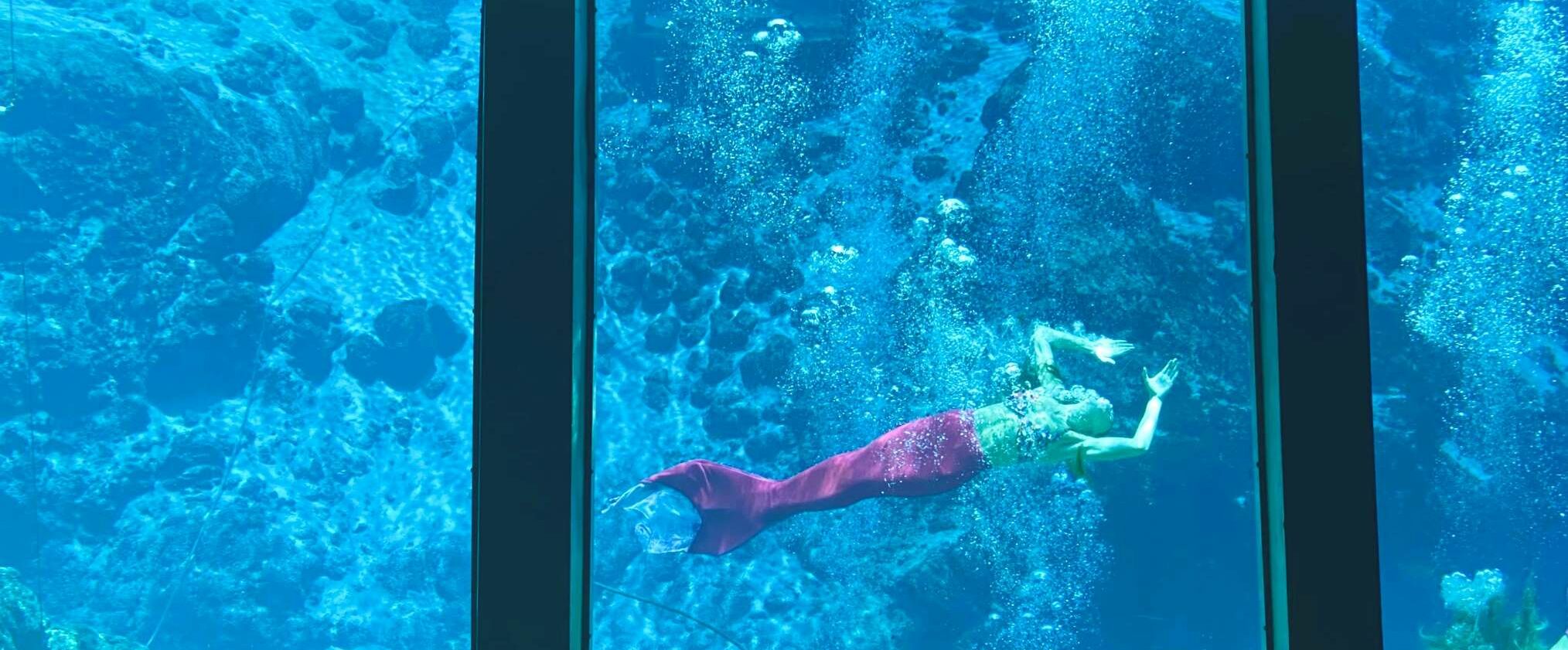Magical mermaid shows at Weeki Wachee Springs on Florida’s Gulf Coast
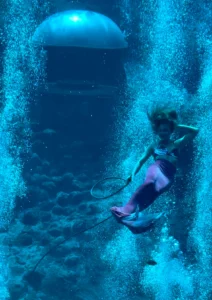
Deep beneath the crystal clear waters of Weeki Wachee Springs some 50 miles north of Tampa on Florida’s Gulf coast, real-life mermaids perform an underwater ballet of graceful acrobatics, gentle, slow dives, and undulating dance moves.
Wearing colorful monofins, shimmery bikini tops, and bright makeup, each mermaid’s long hair gently flows as the women glide, dance, twist, and twirl 16 to 20 feet below the aquamarine water’s surface.
Each day, the mermaids perform scenes from Hans Christian Andersen’s The Little Mermaid to the delight of visitors, who peer at the 35-minute underwater spectacle from a crescent-shaped theater with 19 windows.
For more than 75 years, the mermaids of Weeki Wachee Springs have beckoned drivers off U.S. 19 to watch their mesmerizing underwater shows. These women in sparkly mermaid costumes have been specially trained to perform underwater in the springs, which are the deepest, naturally formed freshwater caves in the U.S.
Like thousands of children, Kelley Parker visited Weeki Wachee when she was growing up in Brooksville, Florida. Today, Parker is a Weeki Wachee mermaid thanks to her sister, who was also a mermaid at the famed park and suggested she audition.
“The most rewarding aspect of being a mermaid is seeing the little kids light up when they see a real-life mermaid,” said Parker.
Weeki Wachee offers a classic taste of Old Florida and Roadside America. It attracts thousands of park-goers daily. The Florida State Park reaches capacity most days in the summer, which is in sharp contrast to the park’s humble beginnings.
How to become a Weeki Wachee Springs mermaid
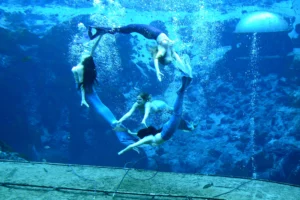
When the natural tourist attraction opened on October 13, 1947, U.S. 19 was a two-lane road with not much traffic. When cars could be heard approaching the park, a handful of women in bathing suits would run out to the road to entice drivers to pull over to catch their show.
The early aquatic performances featured the women drinking Grapette, eating bananas, and performing ballet underwater. While these one-of-a-kind mermaid shows have become much more elaborate, incorporating music, storylines, and costumes, the fundamentals of casting attractive women and teaching them to use special air hoses to breathe underwater are still employed today.
To be a mermaid, there are auditions held each year. Potential mermaids must be 18 years old and pass a swim endurance test that includes swimming 300 yards and treading water for 10 minutes. Those who advance to an underwater audition must perform ballet underwater. New mermaids have to learn to tread water with stiff knees and master dance maneuvers like the flowing knee back dolphin in which one knee is bent while the mermaid arches her back and begins a slow and steady synchronized back flip. The mermaids are paid a starting salary of $15 per hour.
The process of becoming a mermaid is difficult with only a few selected each year.
“For people that are wanting to become a Weeki Wachee Springs mermaid, I would tell them to never let that dream go and no matter how many times they audition to become a mermaid, don’t ever give up!” said Parker, who continues the legacy of performing magical mermaid shows.
Florida, the theme park capital of the world
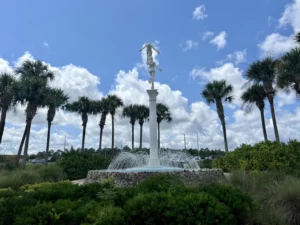
During the park’s heyday in the 1950s and 1960s, Weeki Wachee Springs was owned by American Broadcasting Co., which employed a full-time choreographer and costumer. The broadcasting company also built the 400-seat theater that is still used today. The mermaids performed nine shows a day and celebrities like Elvis Presley flocked to Florida to watch these mythical creatures perform magical underwater shows.
Long before mega, high-tech theme parks like Walt Disney World were built, Weeki Wachee Springs was one of several parks that offered roadtrippers a respite from long drives down the Florida peninsula. It joined Silver Springs State Park, America’s largest springs in Central Florida which opened in the 1820s. This park was famed for its glass-bottom boats that were introduced in the 1870s. As well as the now-shuttered Cypress Gardens, a lush botanical garden in Winter Haven that was Florida’s first theme park when it opened in 1936. It was known for its beautiful Southern belles and water ski shows. Today, it’s the home of LEGOLAND.
Soon, more alluring attractions vied for tourists’ attention. Animal theme park Busch Gardens Tampa Bay opened in Tampa in 1959. Slightly more than a decade later in 1971, Disney World opened in Central Florida’s Lake Buena Vista, ushering in a new entertainment era. From the opening of Magic Kingdom, Central Florida quickly became the theme park capital of the world. Today, there are nearly one dozen major theme parks, including Disney World’s four parks, LEGOLAND, SeaWorld’s two parks, and Universal Orlando’s two parks.
Despite the increasing competition, Weeki Wachee Springs has endured thanks to its iconic mermaid shows within “Florida’s Grand Canyon,” the preservation of American roadside traditions, and nostalgia. It’s the only spring with live mermaids in the world.
Winding Weeki Wachee River
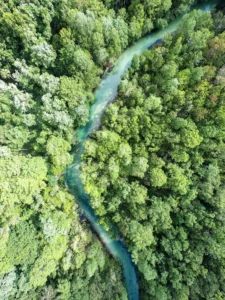
Weeki Wachee, which means “little spring” or “winding river.” was named by the Seminole Indians, Native Americans who lived in Florida during the 18th century. The winding Weeki Wachee River flows from this first-magnitude spring 12 miles to the Gulf of Mexico.
Florida sits on a foundation of limestone and has more springs than any other state or country, according to the Florida Department of Environmental Protection. More than 117 million gallons of fresh water bubble up from subterranean caverns so deep that Weeki Wachee Spring’s bottom has yet to be discovered.
One of the most remarkable aspects of these underwater ballet performances is each mermaid’s ability to remain underwater for the entire performance.
Former Navy Frogman Newton Perry founded Weeki Wachee Springs and came up with the idea for its iconic underwater mermaid performances. He also invented the air hoses that the mermaids use to breathe underwater.
The bubbly air hoses resemble hookahs and have free-flowing oxygen that comes from an air compressor. Unlike heavy SCUBA gear, which includes tanks of oxygen and face masks, the air hoses are light and freestanding. The mermaids are unencumbered as they smile and dance mask-less underwater. They clutch their air hoses, taking periodic breaths with the devices.
“During my training process, the hardest part for me was getting comfortable with the air hose while getting acclimated to a 5-mile-per-hour current and trying to stay neutral underwater,” said Parker.
When ABC bought Weeki Wachee Springs in 1959, they replaced the 18-seat theater Perry had built six feet below the water’s surface with the current 400-seat theater that is 16 feet below the surface. They produced a new elaborate show each year that brought in crowds of locals and tourists who wanted to see the famed mermaids.
ABC sold Weeki Wachee Springs in 1984 as tourists flocked to Disney World. The park that harkened back to yesteryear began to slowly decline. It was on the verge of closing several times.
In 2008, the 538-acre Weeki Wachee became part of the Florida Parks Service and today the park is thriving with guests. Many arrive before the park opens to queue for tickets, which can only be purchased onsite. On most days, the park is filled to capacity within the first hour it opens.
Visitors can take river boat cruises, swim in the springs that are a constant 74 degrees Fahrenheit, splash about in a lazy river, sunbathe on a white sand beach, and slide down waterslides at the seasonally open Buccaneer Bay at Florida’s only spring-fed waterpark. However, the main attraction remains the mermaids.
Once a Weeki Wachee Springs mermaid, always a Weeki Wachee Springs mermaid
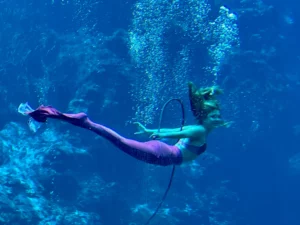
Each mermaid undergoes months of training. In addition to learning choreography and how to breathe on the air hoses, the mermaids also learn how to hold their breath for long periods of time. They also learn to manage the changes in pressure as they dive deep in the springs and dance in place despite the five-mile-per-hour current, which is so strong that it can knock a SCUBA diver’s mask off.
“At first, being underwater for so long can be intimidating, but once you are accustomed to it, you get more comfortable with it and the fear disappears,” said Parker, who has worked at Weeki Wachee Springs for almost eight years. “The more I trained and practiced, the easier it became to hold my breath for so long.”
It took Parker about seven months of training before she performed her first show.
“The main skill that you need to have is buoyancy, along with breath control,” said Parker.
Parker is trained to perform all parts in The Little Mermaid, which includes sisters two and three, Chester, the Evil Sea Witch, and The Little Mermaid. She’s also a safety diver and can perform all show parts in Weeki Wachee Spring’s other show, Wonders of Weeki, which includes musical numbers and the mermaids eating and drinking underwater.
Each mermaid swims two to three shows per day and takes turns hosting in the theater and posing for photos after each show. Some, like Parker, also develop new choreography for shows.
Weeki Wachee offers the same shows every day, The Little Mermaid and Wonder of Weeki. During the holidays, the mermaids also perform themed shows like 2023’s Winter Waterland.
Becoming a master mermaid can take years. To reach this mermaid milestone, mermaids have to choreograph their own dance with costume, create a new move, and swim with a mermaid tail the length of the theater from window 19 to window 1 with only one surface breath.
“Becoming a Weeki Wachee Springs mermaid was the best decision I have ever made. Between the strong bond among the fellow performers, being able to enjoy the natural environment, and watching little kids’ faces light up as they get to meet real-life mermaids, it is a truly rewarding experience,” said Parker.

